Thursday, December 07, 2006
Thursday, August 31, 2006
Karlapat Micro Hydro
Working is progressing slowly due to rains. Not much remains to be complested: the main cable and the penstock.

Karlapat has an amazing banyan tree near the micro hydro site.

The 110-or-so home village also has amazingly sweet kids...non-stop gigglers.

Rains have washed out the road in front of the power house.

The system has 2 pumps as turbines designed for an output of 10-25 kW.
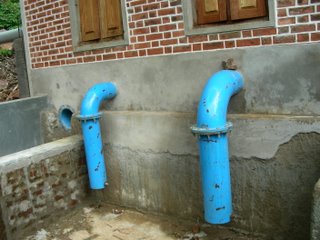

Laying the penstock should have been one of the first steps in implementation, but we could not manage the schedule...


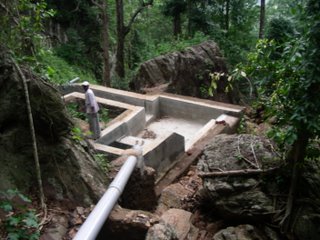
Wednesday, August 23, 2006
Rice Green

Everywhere,
Fully alive,
Transplanted one by one,
The colors of the fields
Make me soar.

You probably know more about the process. From what I've seen during trips to the villages, the rice seeds are planted in fields allocated for seedlings. Once there are seedlings, they are individually transplanted to larger fields.

I have been told most of the rice fields we see here in Orissa are owned by the villagers. About 15% are owned by larger estates. The villagers take turns to work each other's field.
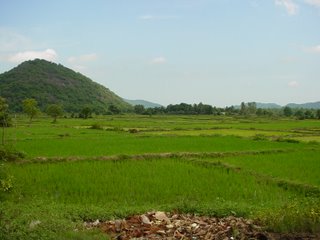

Monday, July 17, 2006
Micro Solar
--Journal entry, June 9, 2006.
Coined by Jos, micro solar refers to a solar home ligting system that has WLED (white light emitting diode) lamps instead of CFL lamps. Because LEDs consume little power (1-3 watts giving enough lumens to read), the panel and battery size become small, along with the cost! Micro solar systems cost Rs. 2500 - Rs. 4000, while full fledged solar home lighting system (power 2 11-17 watt CFL lights) cost around Rs. 15,000, simply because of the larger panel and battery.
The units we are using are supplied by a non-profit organization called Grameen Surya Bijlee. The founder of the company, a compassionate industrialist in Mumbai, has long been facilitating eye operations for rural communities with some friends. During the visits to the village homes, he realized one reason they the villagers have eye problems is the lack of light and the effects of using kerosene. Hence, he founded the Grameen Surya Bijlee Foundation (GSB). He has been excellent in taking our input to improve their systems. GSB is selling the lights only to non-profit groups working in rural/remote areas. For the urban market, GSB has come up with AC LED lights. Of course the debate is whether the LED light is enough. More info at: http://www.suryabijlee.com/
Thanks to Jos' push on giving the systems a try for the cost and portability benefits, I had enough confidence to recommend Gram Vikas to do a pilot project. Below are photos and the steps of the project...not completely flawless but definitely a smooth and positive experience. Two pilot projects with a total of 25 units were installed. Yes, a small project, but with your ideas maybe it can affect others in even better ways. Looking forward to your thoughts!

First we visited the village with demo units and questions on whether they really needed and wanted the micro solar systems. We made sure men and women from rich and poor families were given the space to express their thoughts...still one wonders whether there are some that do not express.

Everyone was wowed by the demonstration and all agreed to committ to the Gram Vikas agreement. Even though the villagers are wowed by the units, it is up to us to help make aware to them that the lights should be useful to them. If they have other priorities for their funds, e.g. medicine, food, then the NGO should help create a community fund from the village contribution for the systems that would address urgent and unplanned needs for money.

During this initial visit, we went to each home to see what they currently used for light. New discovery: charging alkaline batteries using cow dung!

In every region it is always interesting to discover the local livelihoods...like this artisan who's been weaving Sambhalpuri saris for 30 years. ...Wonder who made the machine!

Once a verbal agreement was reached during the initial visit, we set out with the equipment, hoping that it, especially the panels, arrive in one piece. There are various road obstacles—local traffic...

...crossing muddy waters,

...and preventing flat tires.
 Upon reaching ther village, a formal agreement was signed. Yes, all the men and women of this village could write their names; and they trusted our reading of the agreement to them. Gram Vikas is experimenting on various financing models by giving a subsidy of Rs. 1600 to each household.
Upon reaching ther village, a formal agreement was signed. Yes, all the men and women of this village could write their names; and they trusted our reading of the agreement to them. Gram Vikas is experimenting on various financing models by giving a subsidy of Rs. 1600 to each household.The community agreed to pay Rs. 1000 for the system and Rs. 20/month towards a maintenance fund. The fund would become a service fee for 2-3 community members who are more thoroughly trained to maintain the system, e.g. replace batteries after 3 yrs.
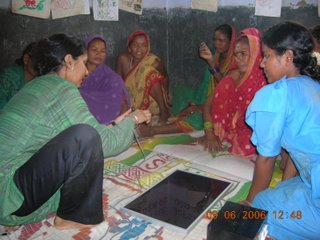
The installation and the training started with having a head to heart session with women from each household. Since they are home more often than their husbands, the women need to know how the systems work, are installed, and how to trouble shoot. The training starts with simple vocabulary and pronunciation: “battery, controller, control box, solar panel, and light”.

Next, we go into basics of each component, especially why the charge controller needs to be the boss and how the sun affects charging.

Yes, I've finally learned that women's issues and involement cannot be improved unless there is equivalent involvement of the men!

Though I have to say that once taught, women are far more diligent in completing the task. I thought these ladies would a an hour at least to connect a few systems for practice....
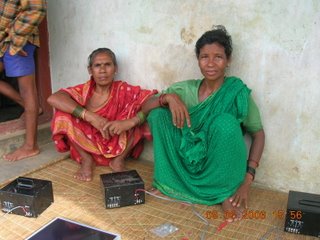
....They were done in 15 minutes and chilling out afterwards!

The installation must actively involve the community. If at all possible, the community should do the actual installation so that they learn how to handle the system.
However, even before the installation, design work should also take in community input. Each household (leading man and woman of each family), after being taught how the sun and wire lengths affects charging, decided the panel, lights, and control box locations, based on their home's layout and their specific need for light. Some families placed lights outside for the porch, some in the kitchen, and some in storage areas. Letting each family decide these locations, taking into account technology design constraints (point the panel south) increase the sense of ownership of the systems. There prevents villagers from taking a passive attitude or selling components should the unit malfunction.
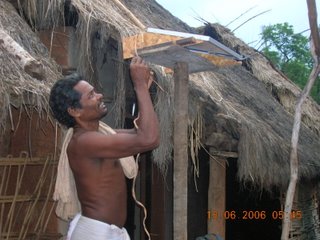
For the mounting of panels, the community had been worried about theft. Hence, we designed the mount such that it can be brought out in the morningand take back into the home in the evening.
We pre-designed, and pre-fabed the rack that holds the panel (it's made from a material called plyboo made from bamboo). Ideally, it would have been nice to have the villagers design it from scratch, but I had to somehow convey that some type of rack to handle the panel was needed since it would be moved twice a day to prevent theft.
However, the design of actual pole and part of the mount that stays outside was left to each household. This helped to make the installation their own effort and own accomplishment, giving more chances of them taking care of the installation. It also helped to address that not every family has the same natural resources to build an identical mount

Thanks to Green Empowerment volunteer Drew and my friend mark...AND the Gram Vikas art section, we were able to make a pictorial training tool that is left with the villagers as reminder on how to install and train.
...In the US, Kinko's rocks...here, this poster took unbelievable effort to produce with just manual printing methods.

After the installation and maintenance discussion with each household, each family completed their own installation. The woman of household connects one light...having participated in the women's group training, by this time the ladies had full confidence in installing in front of their presuming husbands.

...All smiles upon hitting the switch and seeing the light turn on.

The man of household connects the second light. (Yes, we were not using a safe screw driver...long story on why no other choice that day.)

Each family took it upon themselves to keep the installation neatly maintained. Each one had their own way of keeping the box away from falling items and heat in their small homes.

The next morning, when a couple of batteries were not charging, with a little encouragement the ladies did the troubleshooting themselves and solved the problem!!! ...I couldn't have had a better birthday present.
 (That's Yaniis, an all-star volunteer from Canada, in the middle...not an abnormally tall and fair tribal!)
(That's Yaniis, an all-star volunteer from Canada, in the middle...not an abnormally tall and fair tribal!)With simple steps in involving the community, the lights simply become an excuse to bring dignity to marginalized communities.
-----------------------------------------------
In the horizon is nearly a flawless project: Colorado College sponsoring micro solar units to a 70 home village which after 8 years has been transformed from a village that had deaths from malnutrition to a village that has a healthy community grain bank and community fund. The villagers have agreed to pay full cost for the systems, and for those who cannot pay full cost the community fund will give a loan so they have more time to gain ownership of the system. The pluses of this scenario:
-Colorado College will sponsor the units, so the villagers money can go to the community fund
- It's always an internal debate on whether we are taking away something by giving them lights and having them contribute something towards them; but in this case, the community fund can address maintenance, medicinal, or other needs for money.
-Students from Colorado College will train each family to install and maintain their own units, allowing an exchange of perspectives and cultures. The students will live with the villagers.
Monday, June 05, 2006
In Awe: Conclusion
Under the Mother Teresa Hospital's care, the old man has drastically improved. He smiles and has started eating better. He doesn't have TB and will soon go to his village once he gains enough energy. Rahul's has a friend going to the old man's village in Rajasthan to find out the story on why he was abandoned.
...Thanks for all the comments and staying to tuned to Rahul's remarkable efforts. I am sure your wishes helped the situation.
Sunday, June 04, 2006
Pakistan: Islamabad, FATA
The genuine respect I received during the visit...from EVERYONE I met was unmatched from any other place...I miss that special flow that Pakistan nurtures. Here are some photos of the field visits.

Village girls taking a break from carrying water up to their homes.
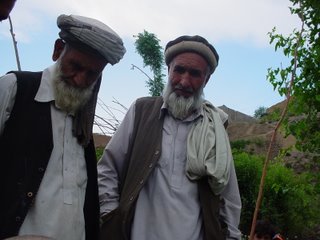
Elders looking over our shoulders as we inspected the well that needed the solar pump.
Saturday, June 03, 2006
Pakistan: Lahore
Once I reached Lahore, I realized there really was no need for such security. I call Roop, a friend's friend and a phenominal volunteer for Friends Without Borders (www.friendswithoutborder.org) , from the Lahore-Dehli bustop for directions. Never having met, she openly welcomes me into her home...and into a dream. I was expecting to find a city much like any city in India dealing with over population and lack of the Western world's definition of infrastructure. I found the complete opposite.
Lahore has a center which has its fair share of slums. I didn't get a chance to see this part of the city in my 24hrs there. Roop's mom is head of the Microbiology Dept. at the University of the Punjab, the largest university in Asia...as I was told. The campus could have been Stanford...and Roop's family could have easily been a Bay area family.
Her mom is extremely outgoing. Her Nanima is extremely open. Her Aunt is professor of Environmental Studies. I was showered with so much love. Nanima non-stop told me of her Indian friends and memories she treasures of them. ...She treated me as if I transpired the priceless for her...again great showers of Love...in her thick Punjabji...me replying in my wanna-be Hindi.
...Roop and I tried our best to explain Friends Without Borders to Nanima....little did she know that she embraces the India-Pakistan context that Friends Without Borders wants to resurrect.
Monday, May 29, 2006
Deathless Rose
Rose symbolizes love.
There is a love that is human and there is a love that is divine. Human love depends upon human factors and is mixed with human motives. This love imposes a claim on the loved one. It demands recognition, it insists on a response. If that is not forthcoming, there is disappointment, resentment, anger. It is a conditional transaction. It is transient.
But divine love is unconditional. It exists for its own sake, it flows because it is its nature to do so. It does not seek a return. One loves because one cannot help loving. It is endless, boundless, deathless.
And the source of this immortal love is your psychic which is itself an immortal spark of God. This spark is there deep in the core of our being, in the inmost heart-cave, as a perennial spring of sweetness and love. As you feed it with thoughts turned towards the light, emotions that are more and more purified, energies that consecrated and physical movements oriented towards the Indweller, the spark grows into a flame. The rose blossoms. There is a continuous outflow of love and sweet rapture.
Attend and become aware of this sanctum in the earth where the bud of love waits to blossom into a full-petalled rose at the feet of Godess.
--M.P. Pandit on Light by Sri Aurobindo
Wednesday, May 17, 2006
In Awe
Rahul Brown (rahulbrown.livejournal.com) is a fellow "ABCD" (American born compassionate Desi) committed to various acts/projects of service and writing a book in India. Last week Rahul discovered a 70-yr old, hungry and wet man in one of Ahmedabad's gutters. He took it upon himself to stop all activity in his life to serve this old man as his own.
Rahul admitted the old man into Civil Hospital...which has turned out to be quite uncivil in repeated situations. The hospital is completely neglecting the old man, as well as other patients. Rahul is waiting to get TB test results before demitting the old from the hospital. Due to hospital slacking on getting the test done, Rahul thought he could speed up the process by pushing at every stage. ...At one point, he was asked to transport an open vial of blood from one hosptial wing to the other!
Daily, Rahul feeds and cleans the old man. Yesterday, he had two helpers from Manav Sadhna--one helped cleaned the old man's self-soild pants and the other watched Rahul's bag.
The old man is hard of hearing and doesn't understand Gujarati or English. He is from Rajasthan....Rahul is determined to get this old man well enough to return him to his village in Rajasthan.
...When I told Rahul how much in awe I am of his act to stop everything else and focus on this old man, he simply replied in his calm and deep tone, "I am getting more than I am giving."
...I've been trying to find ways to help the situation. Rahul says money will help little, since taking the old man out of the hospital is a no-go until he gains his strength. If you have family in Abad that could help in taking shift to watch after the old man this week, write me.
...Lastly, I share this story with you to ask you to notice the next you're wanted and received in a situation of need, out of the blue.
Thursday, April 20, 2006
“The heart of a world in which all hearts are one.”
–The Universal Incarnation, Sri Aurobindo.
I waited to see where the 5-person packed auto rikshaw was going and whether I could be the 6th. Bargaining rikshaw prices in
As I got on, I was still in search of how I’d cross the border by road. For the last few days people kept talking of a bus and a train from
‘Uncle’ is a Muslim from
Realizing that in the larger picture it hasn’t been so long since the two nations were one, made me discount my own uncle’s remark that later in the day, “Be careful. The country is filled with dangerous people.” What my uncle didn’t think about is just as the halves of separated families like that of the Uncle from
I didn’t make it to
(Sparse email until May 10.)
Monday, April 17, 2006
Hope!!
http://www.ecogreenunit.net/
Win-win for the "developed" and the "developing". As alwasy, open to your ideas.
Thursday, April 13, 2006
Inspiration
Who would have thought an old David Hockney drawing would yield a hospital in India and a clinic in Mexico? Margit Bisztray profiles Michael Daube and his extraordinary organization, Citta.
In 1994 Artist Michael Daube was rummaging through a dumpster near his Jersey City loft, looking for sculpture materials, when he came across a drawing in a rickety frame signed with a funky initial. Having taken an art attribution course, he has an inkling that it might be a David Hockney. A professional confirmed his hunch, and Daube, then 30, sold his find for $30,000.
With his money, he took off for India, were he'd traveled six years earlier. The son of a steel worked and a housewife, neither a high school graduate - Daube had survived a sometimes turbulent family life by dreaming of cultures, far from his rural upstate New York home.
On his first trip, Daube was struck by the Buddhist concept of compassion - a love that makes one's own suffering and happiness inseparable from those of others - which he'd witnessed while working at Mother Teresa's mission in Calcutta. When he returned after the Hockney sale, he went back to Mother Teresa and asked her how he might practice compassion $18,000 richer. She suggested opening a school in the country's poorest, most heavily tribal state, rural Orissa. Prone to floods and cyclones, it's an area about which even devoted aid workers ask, "Why would you go there?"
Daube soon found out what they were talking about. "In Orissa, people with extremely sick babies approached me begging for any kind of medicine, even aspirin," he says. "I saw a man in a basket hanging from bamboo poles held by two skinny men who intended to carry him more than 18 miles through mud to the nearest hospital. Instead of building a school, I began to build a hospital."
It quickly became clear that Daube would need more money to complete the project, so he returned to New York in search of work. In a stroke of good fortune, a friend introduced him to musician David Byrne and artist Adelle Lutz, who ended up giving him odd jobs. ("They knew I could help with art projects as well as fix a fence," says Daube.) Over the next two years, he would work for Byrne and Lutz until he'd saved enough money, then travel back to Orissa to add a floor or roof to the hospital. In 1995 Byrne performed a concert to raise funds for a clinic he and his assistant convinced Daube to help them build, in Chiapas, Mexico, to serve the Mayans. With both projects to manage, Daube formed an organization he called Citta, the Sanskrit word meaning "mind-heart": soon director Jonathan Demme and actress Thandie Newton lent their support.
Most recently, Citta has thrown a lifeline to the poorest regions of Nepal, where woman used to leave newborns in the snow to die rather than watch them starve. Now mothers support their families making jewelry and doing bead and needlework commissioned by New York designers. More medical centers, as well as orphanages and schools, may follow. "After we are involved in a region, it usually becomes apparent what else is needed," says Daube. "Our approach is holistic. There is never just one aspect that allows a community to emerge from poverty."
These days Daube is on the road most of the time, but he has become the unofficial big brother to Babu, an eight-year-old Orissa boy. Abandoned in a temple as a child, Babu now hangs out at the hospital in Orissa, which serves 60,000 people, and he's learning to read at the newly completed school. From that original discovery of the Hockney, Daube has opened up an entire world of beauty and possibility.
http://www.citta.org/publicity.html
Wednesday, April 12, 2006
Jai Bajrang Bali!!

Ek, doa, Jai Bajrang Bali!! It took some serious muscle to unload the hardware.
(Jai Bajrang Bali is a phrase used to incarate the strength that Lord Hunuman has....big Hunuman fans in this part of Orissa.)

...Although joking around in this pic, woman-muscle goes a long way too. ...i had great fun unloading stones and cement with them...They didn't hesitate in filling me up with dried tamrind snacks....way to take the mind off the mining concerns.
...I asked the ladies why they wanted light...why they actively gave their time to the project. Their reply: "If there was no project, we would not meet people like you. We would never know what is outside."
Sunday, April 02, 2006
Karlapat and Amthagouda
...We have arrived after dark. The lights are on, but ironically I still cannot decipher all his features. He is Arjun, the boyish looking 20 yr old leader of the village. I am introduced as the 'madame replacing Michael'...I receive stares in response to the intro. I catch an older lady sprawled out on the patio of her cookie-cut, Gram Vikas built home. I interrupt the intros to ask what's happened. "She's over dosed on the local liquor." Nothing new I am told....but I was so happy to hear that Arjun was not going to accept drinking as a village ritual. Arjun and his co-leader are the only two in the village who do not drink. Three years ago, Arjun forced the gov't to close its nearby liquor shopt. If people made their own, he publicly tied and scolded any man that was drinking...his motivation in relieving the chaos that follows drinking resulted in a liquor free village for at least a year. Unfortunately the gov't has re-opened the shop. ...We talked about how evening activities could now be held with the new lights, in order to distract people from drinking. Hope they happen soon. ...We were there to look at the new lights...Arjun became the Light I had been searching for.
Such images in the villages of Karlapat (in process of getting a micro hydro system) and Amthagouda (has a newly finished micro hydro system), two tribal villages near Bhavanipatna (the town I am in now), Orissa, have occupied my mind and heart like no other during the last four days. They are teaching me about their will and my judgements.
The turbine and cable material arrived unexpectedly on-time. We will stay an extra week, until April 14 or so No email or phone.
Saturday, March 25, 2006
Berampur, Orissa
...It is difficult to form a pinhole around Gram Vikas (www.gramvikas.org), the group I will be involved with, forgetting everything else. ...Often so-called projects become too isolated and turn into ego traps, instead of genuine help.
Thankfully the group is so intimately involved with the communities it helps, that it doesn't see development as projects...rather more as a process.
The second micro hydro will be installed in the next two weeks. Very anxious to meet the tribal communities. It is amazing what my Australian predecessor (whom i'll shadow for a few weeks) has been able to do with the energy program, specifically with micro hydro development.
Wednesday, March 22, 2006
Arunachal shots: Women in Action

Although the solar systems were for a remote monastry, we were initally hosted by a nunnery.
The Colorado College students exposed the little nuns to ultimate frisbee and soccer. ...Little teaching was needed...Only smiles.

Though the students main task was first to learn the why's and how's of solar design/ installation and second to teach the monks.
Monday, February 27, 2006
Transformations and Ahead...
It has been non-stop showering of them since the start of the year: the Arunachal trip and its team, being with a friend as she left her body, learning Vipassana, staying in Auroville for work, spending time with family in Ahmedabad, helping sort out others' woes in Delhi...and now finally leaving for Orissa.
In all of the journeys, I keep running into others who are also seeking more...and more of myself that is seeking more! :-)
Moving onto less abstract talk, the energy projects are coming together with both WLEDs solar systems and micro hydro work. Hope to do both in Orissa. Details later.
Monday, February 20, 2006
:-)
Saturday, January 28, 2006
More...
"There is a fire burning there, In the deep quietude of the heart. It is the divinity in you- your true being. Hear its voice. Follow its dictates."
-The Mother
More on Sri Aurobindo and the Mother:
http://www.miraura.org/teaching.html
More on the Vipassana retreat...there are centers world-wide:
www.dhamma.org
(No internet/phone until Feb. 10)
Friday, January 20, 2006
The Vipassana course was pushed to Jan. 29....i wanted to be with a friend and her family in Puna the last few days....She left her body yesterday. She is an utterly beautiful soul, who selflessly touched all who came into her Life. She is a devoutee of Sri Aurobindo and the Mother. We'll be going to Ponditcherry this week in her memory...
"Peace, peace upon all the earth!"
"May all esacpe from the ordinary consciousness and be delivered from the attachment for material things; may they awake to the knowledge of Thy divine presence, unite themselves with They supreme consciousness and taste the plentitude of peace that springs from it."
-The Mother
